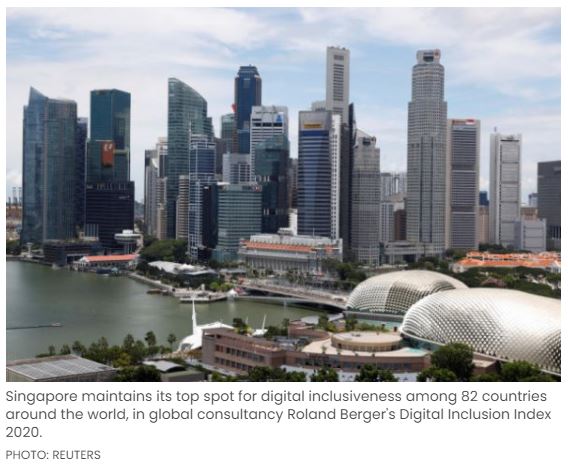Singapore ranks 1st in digital inclusiveness, but South-east Asia lags: report
SINGAPORE maintains its top spot for digital inclusiveness among 82 countries around the world, in global consultancy Roland Berger’s Digital Inclusion Index 2020. But around 150 million adults in South-east Asia – or nearly a third of the population – remain excluded from digital technologies, casting a spotlight on the region’s digital divide.
The report defines digital inclusion as the empowerment of individuals and societies to effectively use information and communication technologies (ICT), enabling them to contribute to and benefit from today’s digitalised economies and societies. According to the report, a growing “digital divide” exists between the “haves” and the “have-nots” in South-east Asia.
Roland Berger’s index measures digital inclusiveness by scoring countries in four categories: accessibility, affordability, ability (or digital literacy), and attitude (trust and enthusiasm) towards ICT. Accessibility is the most important requirement, with a weightage of 40 per cent in the scores. This is followed by affordability (30 per cent); ability (20 per cent) and attitude (10 per cent).
Data was compiled for the index from sources such as government publications, global databases and international surveys.
Singapore took the top spot among the 82 countries ranked, followed by Sweden, Denmark, Netherlands and the United States. As a region, however, South-east Asia ranked only fifth of seven global regions included in the index, and below the global average.
The report found that while many regions’ scores were boosted by outliers, South-east Asia’s score was dragged down as most of its countries ranked in the bottom half of the index. The second-highest ranked country on the index was Malaysia (21st), followed by Brunei and Thailand (38th), Vietnam (44th), the Philippines (45th), Indonesia (49th), Myanmar (55th), Cambodia (57th) and Laos (69th).
South-east Asia’s rankings were hampered by low scores for affordability and ability, due to large low-income populations, and levels of education and digital literacy in emerging areas that lag behind the global average.
Groups most susceptible to digital exclusion, as identified by the report, include low-income households, rural communities, the elderly, the illiterate, and persons with disabilities. At the enterprise level, micro, small and medium (MSMEs) are at greater risk compared to larger businesses.
On a brighter note, South-east Asia scored at or above the global average for accessibility and attitude, driven by factors such as infrastructure developments supporting smartphone adoption, and a young demographic.
The report also looked at data from 2020, and compiled data retrospectively from 2017, to trace changes in scores over time. In Singapore, for example, scores on “attitude” (trust and enthusiasm towards ICT) dropped from 85 of 100 in 2017, to 82 in 2020. This was attributed to the rise of Internet scams and concerns over personal data security.
Overall, Singapore, Malaysia, Vietnam, Myanmar and Cambodia either maintained or improved their rankings between 2017 and 2020. But Brunei, Thailand, the Philippines and Indonesia slipped.
The report’s co-authors, Damien Dujacquier and John Low – senior partners at Roland Berger – have called for measures to bridge the digital divide. Otherwise, they warn, the region could see reduced economic growth and weakening social cohesion.
In dollar terms, their projections also suggest digital inclusion in South-east Asia could translate to taxpayer savings of US$7 million to US$3.3 billion a year, depending on the country. These savings are realised as more individuals utilise digital platforms that optimise government services and economic activities.
“At least US$15 billion of revenue and savings per year can be unlocked in South-east Asia by bridging this digital divide,” said Mr Low.
Source: https://www.businesstimes.com.sg/asean-business/singapore-ranks-1st-in-digital-inclusiveness-but-south-east-asia-lags-report


 Thailand
Thailand




